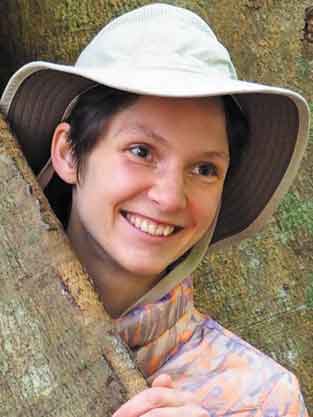Being small is what mites do best, as is reflected in their English name, which originally referred to a small portion or a coin of very low value (Brown Citation1993). We are surrounded by these tiny arthropods that we rarely notice, even when they are biting us, except for the few that are relatively large and colourful. Water mites of the genera Eylais and Limnochares, for example, attain lengths of 5 mm (HP, pers. obs.), the giant velvet mite Dinothrombium tinctorum (Linnaeus) gets up to 1.4 cm (Thor and Willmann Citation1947), and engorged females of many tick species exceed 2 cm (e.g. Amblyomma hebraeum [Koch]) (Weiss and Kaufman Citation2001). Most mites, however, are 1 mm or less in length as full grown adults, community collections typically average well below 1 mm (Walter and Behan-Pelletier Citation1999), and some mites are truly microscopic (<100 µm long for many juveniles).
Have mites always been minute through their history, or do they show a trend of increasing or decreasing size over evolutionary time, as has been posited for other groups of animals (Bell Citation2014)? One can certainly cherry-pick fossil mites that were very small (<100 µm eriophyoid, Sidorchuk et al. Citation2015) and others that were enormous (~1 cm erythraeoid, Dunlop et al. 2018), but to truly answer the question one must thoroughly review the entire palaeontological literature on mites for trends. In this issue, the late Ekatorina Sidorchuk presents a masterful job of gathering and analysing more than 200 records of fossil mites going back more than 400 MY.
Being small has allowed mites to exploit microhabitats that are unavailable to larger-bodied organisms. Indeed, larger plants and animals provide a cornucopia of mite microhabitats and this is likely one reason for their very high diversity (Walter and Proctor Citation2013). Yet within the Mesostigmata, it seems at first glance that the largest species are the ones that have symbiotic relationships with other animals (e.g. Seeman Citation2017). Is this true, though, and does the nature of the symbiosis (commensalism vs. parasitism) influence body size? Owen Seeman and Helen Nahrung compiled more than 3000 records of body sizes to test these and other questions about ecological correlates of size in the Mesostigmata.
Ecologists have long examined the distribution of body sizes among coexisting species for both theoretical (e.g. Allen et al. Citation2006) and applied purposes (Dolbeth et al. Citation2014). In less stable or fragmented habitats, body size distributions are often predicted to shift towards smaller-bodied species. Similarly, the prevalence of parthenogenetic species is though to be correlated with degree of habitat stability (e.g. Hörandl Citation2006). In this issue, Adrian Brückner and colleagues assess how variation in forest floor habitat correlates with body size and reproductive mode in assemblages of oribatid mites.
When one studies small-bodied organisms like mites, there are many benefits to their compact nature (e.g. it is easier to store the preserved bodies of a thousand water mites than that of a single water buffalo). On the downside, observations of reproductive or feeding behaviour can be almost impossible when the body parts in question are only a few thousandths of a millimetre long. Samuel Bolton and coauthors employ several microscopical techniques to tackle this problem in their investigation of the functional morphology of the exceedingly small chelicerae of a tiny vermiform soil mite. Their results suggest homologies with the mouthparts of the smallest of all mites, the vermiform gall and rust mites of the Eriophyoidea, and support a reinterpretation of their taxonomic placement.
Sadly, as we were writing this introductory piece, we learned that one of our authors, Dr. Ekatorina Sidorchuk, had died suddenly in an accident. A young life cut short is always a tragedy and the premature ending of the career of such a gifted scientist is a deep loss to Palaeontology and Acarology. We dedicate this special volume to her memory.
In memorium Ekatorina Sidorchuk
 Legend: Dr Ekaterina A. Sidorchuk 1981–2019 (Photo D.E. Walter)
Legend: Dr Ekaterina A. Sidorchuk 1981–2019 (Photo D.E. Walter)
References
- Allen CR, Garmestani AS, Havlicek TD, Marquet PA, Peterson GD, Restrepo C, Stow CA, Weeks BE. 2006. Patterns in body mass distributions: sifting among alternative hypotheses. Ecology Letters. 9:630–643.
- Bell M. 2014. Patterns in palaeontology: trends of body-size evolution in the fossil record – a growing field. Palaeontology Online. 4:1–9.
- Brown L, ed. 1993. The New Shorter Oxford Dictionary, Vol. 1, Oxford: A-M. Clarendon Press.
- Dolbeth M, Raffaelli D, Pardal MA. 2014. Patterns in estuarine macrofauna body size distributions: the role of habitat and disturbance impact. Journal of Sea Research. 85:404–412.
- Hörandl E. 2006. The complex causality of geographical parthenogenesis. New Phytologist. 171:525–538.
- Seeman OD. 2017. Megisthanus leviathanicus sp. nov. (Parasitiformes: megisthanidae), the largest known Mesostigmata, a symbiont of the beetle Mastachilus australasicus (Coleoptera: passalidae). International Journal of Acarology. 43:263–285.
- Sidorchuk EA, Schmidt AR, Ragazzi E, Roghi G, Lindquist EE. 2015. Plant-feeding mite diversity in Triassic amber (Acari: tetrapodili). Journal of Systematic Palaeontology. 13:129–151.
- Thor S, Willmann C. 1947. Trombidiidae. Das Tierreich. 71b:187–541.
- Walter DE, Behan-Pelletier V. 1999. Mites in forest canopies: filling the size distribution shortfall? Annual Review of Entomology. 44:1–19.
- Walter DE, Proctor HC. 2013. Chapter 11: mites and biological diversity. In: Mites: ecology, evolution & behaviour – life at a microscale. Dordrecht: Springer. p. 447–460.
- Weiss BL, Kaufman WR. 2001. The relationship between ‘critical weight’ and 20-hydroxyecdysone in the female ixodid tick, Amblyomma hebraeum. Journal of Insect Physiology. 47:1261–1267.
